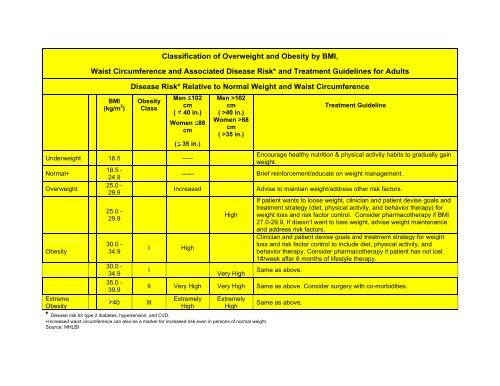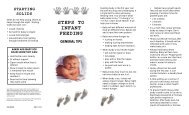Classification of Overweight and Obesity by BMI,
Classification of Overweight and Obesity by BMI,
Classification of Overweight and Obesity by BMI,
Create successful ePaper yourself
Turn your PDF publications into a flip-book with our unique Google optimized e-Paper software.
<strong>Classification</strong> <strong>of</strong> <strong>Overweight</strong> <strong>and</strong> <strong>Obesity</strong> <strong>by</strong> <strong>BMI</strong>,Waist Circumference <strong>and</strong> Associated Disease Risk* <strong>and</strong> Treatment Guidelines for Adults<strong>BMI</strong>(kg/m 2 )Disease Risk* Relative to Normal Weight <strong>and</strong> Waist Circumference<strong>Obesity</strong>ClassMen 102cm( 40 in.)Women 88cm( 35 in.)Underweight 18.5 -----Normal+<strong>Overweight</strong><strong>Obesity</strong>Extreme<strong>Obesity</strong>18.5 -24.925.0 -29.925.0 -29.930.0 -34.930.0 -34.935.0 -39.940 IIII HighIMen >102cm( >40 in.)Women >88cm( >35 in.)Treatment GuidelineEncourage healthy nutrition & physical activity habits to gradually gainweight.----- Brief reinforcement/educate on weight management.Increased Advise to maintain weight/address other risk factors.HighVery HighIf patient wants to loose weight, clinician <strong>and</strong> patient devise goals <strong>and</strong>treatment strategy (diet, physical activity, <strong>and</strong> behavior therapy) forweight loss <strong>and</strong> risk factor control. Consider pharmacotherapy if <strong>BMI</strong>27.0-29.9. If doesn’t want to lose weight, advise weight maintenance<strong>and</strong> address risk factors.Clinician <strong>and</strong> patient devise goals <strong>and</strong> treatment strategy for weightloss <strong>and</strong> risk factor control to include diet, physical activity, <strong>and</strong>behavior therapy. Consider pharmacotherapy if patient has not lost1#/week after 6 months <strong>of</strong> lifestyle therapy.Same as above.II Very High Very High Same as above. Consider surgery with co-morbidities.ExtremelyHighExtremelyHigh* Disease risk for type 2 diabetes, hypertension, <strong>and</strong> CVD.+Increased waist circumference can also be a marker for increased risk even in persons <strong>of</strong> normal weight.Source: NHLBISame as above.
Pediatric <strong>Overweight</strong> Screen<strong>BMI</strong> > 95%<strong>Overweight</strong><strong>BMI</strong> 85-94%At risk <strong>of</strong>overweight<strong>BMI</strong> < 85%Not at risk <strong>of</strong>overweightFamily history Blood pressureLarge change in <strong>BMI</strong> Weight concernsChronic illness (asthma, diabetes, etc)YesNoIn-depthmedicalassessmentNote in chartPatient educationReturn next year for reevaluationReturn nextyear for screenSource: Himes <strong>and</strong> Dietz, American Journal <strong>of</strong> Clinical Nutrition, 1994.2 – 7 years old 7 years or older<strong>BMI</strong>85-94%<strong>BMI</strong>> 95%<strong>BMI</strong>85-94%<strong>BMI</strong>> 95%Complications*Complication*NoYesNoYesWeightMaintenanceWeight LossWeightMaintenanceWeight LossComplications* such as mild hypertension, dyslipidemia, <strong>and</strong> insulin resistance. Source: Barlow <strong>and</strong> Dietz, AAP, 1998.







